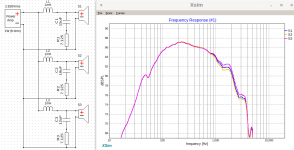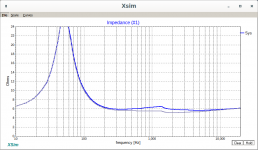Hello,
So after 15 to20 years, the capacitance of a bipolar lytic is agging enough in the speaker filter for people wanting to change it.
If I know ears adapts themselves little by little and don't notice that agging years after years, it's clear after a filter refuurbishing with brandnew caps the speaker was not the same.
I was asking how is translated the sonic experience when a cap is getting too much old and see its esr and capacitance changing in an impedance zobel network correction circuit that flat impedance resonance if I understand correctly.
Let say the impedance curve is low enough, for illustration 4 ohms to 2 ohms. Let say the in the RC after agging a 100 uF cap is measured after 2 or 3 decades at 130 uF - knowing often the capacitance precsion fo a standard bipolar was 20% - What is the result in the impedance network of that capacitance rise and the result when listen to it with the speaker please ?
I surmise it is lowering perhaps the impedanceresonance below the average flat impedance curve and can be a danger for the amp by a too much low Z there, especially in the bass area ? (let me think a bout the treble in ESL speakers when dropping below 2 ohms in the high end of the trebles-
Less bass are perceveid ? I also surmise the esr of the cap vastly increased as the capacitance of a lytic cap when agging is first lowering then increasing above its initial value... so at the end increase the Z of the zobel network as well ! Does it age faster than serie caps with the driver in a speaker filter ?
Sorry, several questions in one,
many thanks for any input about that,
cheers.
So after 15 to20 years, the capacitance of a bipolar lytic is agging enough in the speaker filter for people wanting to change it.
If I know ears adapts themselves little by little and don't notice that agging years after years, it's clear after a filter refuurbishing with brandnew caps the speaker was not the same.
I was asking how is translated the sonic experience when a cap is getting too much old and see its esr and capacitance changing in an impedance zobel network correction circuit that flat impedance resonance if I understand correctly.
Let say the impedance curve is low enough, for illustration 4 ohms to 2 ohms. Let say the in the RC after agging a 100 uF cap is measured after 2 or 3 decades at 130 uF - knowing often the capacitance precsion fo a standard bipolar was 20% - What is the result in the impedance network of that capacitance rise and the result when listen to it with the speaker please ?
I surmise it is lowering perhaps the impedanceresonance below the average flat impedance curve and can be a danger for the amp by a too much low Z there, especially in the bass area ? (let me think a bout the treble in ESL speakers when dropping below 2 ohms in the high end of the trebles-
Less bass are perceveid ? I also surmise the esr of the cap vastly increased as the capacitance of a lytic cap when agging is first lowering then increasing above its initial value... so at the end increase the Z of the zobel network as well ! Does it age faster than serie caps with the driver in a speaker filter ?
Sorry, several questions in one,
many thanks for any input about that,
cheers.
Re an ageing capacitor in a zobel network, allow me to start the ball rolling.
You are correct in saying that if the cap value becomes too high, you will get an impedance dip which could stress the amplifier. The larger the cap value, the lower the frequency at which the zobel will shunt the signal around the woofer.
Soundwise, the low pass crossover will attentuate the highs to a greater degree.
You are correct in saying that if the cap value becomes too high, you will get an impedance dip which could stress the amplifier. The larger the cap value, the lower the frequency at which the zobel will shunt the signal around the woofer.
Soundwise, the low pass crossover will attentuate the highs to a greater degree.
Hi Galu, how fine 🙂
Thank you for the input. So possibly create a lower dip just before the initial driver impedance rise, However I'm not sure to understand the second statment.
What please is atenuated in the high pass ? So you mean in the illustration that the high pass of the bass (a capacitor) will be atenuated: spl curve of the beginning of the mid cause it ads a greater Z in serie at the XO point?
What if the XO is in the flat average curve after the natural resonant rise ? the new dip created before that rise will change also that flat area after ?
I will try to simulate a a zobel that pad down the resonant rise of the mid or to pad down a 8 ohms mid in front of a 4 ohms bass....
I'm not sure why a zobel is used in the bass filter but perhaps to create a stiffer short cut for the mid not seing the spl peaks of a bass driver in a the medium range ?
Does it mean one should measure the impedance of an old speaker to know exactly where is the impedance rise of a driver when refurbishing the filter : on the importance of putting the atenuation in the right frequency? This frequency being given by the capacitance value of the cap - and the cumultaed esr + resistor giving the db atenuation of the resonant peak ?
The mess in the illustration given is the cap could be the 100 uF marked on the cap but being not important in the initial 20% precision of manufacterers or at the opposit being sorted out then 130 uF will be circa 30% more !
Tat's odd to me cause I have seen some zobel on a same speaker but on different drivers having for instance in the medium a capacitance value that reduced (in relation to the cap marking) and an other one in the bass where the capacitance value went oposite with a raise of the capicitance ! Soething like not an assymetrical agging or a sorted out caps scenario perhaps by the speaker manufacterer in the 20% precision lytics usualy have !!
Thank you for the input. So possibly create a lower dip just before the initial driver impedance rise, However I'm not sure to understand the second statment.
What please is atenuated in the high pass ? So you mean in the illustration that the high pass of the bass (a capacitor) will be atenuated: spl curve of the beginning of the mid cause it ads a greater Z in serie at the XO point?
What if the XO is in the flat average curve after the natural resonant rise ? the new dip created before that rise will change also that flat area after ?
I will try to simulate a a zobel that pad down the resonant rise of the mid or to pad down a 8 ohms mid in front of a 4 ohms bass....
I'm not sure why a zobel is used in the bass filter but perhaps to create a stiffer short cut for the mid not seing the spl peaks of a bass driver in a the medium range ?
Does it mean one should measure the impedance of an old speaker to know exactly where is the impedance rise of a driver when refurbishing the filter : on the importance of putting the atenuation in the right frequency? This frequency being given by the capacitance value of the cap - and the cumultaed esr + resistor giving the db atenuation of the resonant peak ?
The mess in the illustration given is the cap could be the 100 uF marked on the cap but being not important in the initial 20% precision of manufacterers or at the opposit being sorted out then 130 uF will be circa 30% more !
Tat's odd to me cause I have seen some zobel on a same speaker but on different drivers having for instance in the medium a capacitance value that reduced (in relation to the cap marking) and an other one in the bass where the capacitance value went oposite with a raise of the capicitance ! Soething like not an assymetrical agging or a sorted out caps scenario perhaps by the speaker manufacterer in the 20% precision lytics usualy have !!
I have been simulating both zobels in XSim with the 8 ohms driver of the soft : plate spl curve.
The area is realy larger than I thought.
For instance at 150 hz, there is 0.7 ohms deeper atenuation with 130 hz than 100 hz. That indeed means the attenuation is beginning before. Something 2.7 ohms at 150 hz instead 2 ohms attenuation.
However I don't see in XSim the spl moving. I assume it is different in the real world related to the amp you have...
Ok, seems the RLC can be made short in width and more suited for the impedance driver peak itself and the RC zobel more to marry seamlessly the impedance of two driver two drivers ! - match their Z at cut-off- . Mysterious to me if the upper driver has a higher nominal Z : for illustration a 4 ohms bass then a 8 ohms mid !
The area is realy larger than I thought.
For instance at 150 hz, there is 0.7 ohms deeper atenuation with 130 hz than 100 hz. That indeed means the attenuation is beginning before. Something 2.7 ohms at 150 hz instead 2 ohms attenuation.
However I don't see in XSim the spl moving. I assume it is different in the real world related to the amp you have...
Ok, seems the RLC can be made short in width and more suited for the impedance driver peak itself and the RC zobel more to marry seamlessly the impedance of two driver two drivers ! - match their Z at cut-off- . Mysterious to me if the upper driver has a higher nominal Z : for illustration a 4 ohms bass then a 8 ohms mid !
Not sure I understand either! I only intended to start the ball rolling. 🙂I'm not sure to understand the second statment.
Roooooo 🙂
well, that's always mysterious to me when it comes to impedance curves and amps and how the changes are perceveid when listening to it.
As it flows some curent more, do you thing a cap in a zobel is agging faster than the one in serie with the driver voice coil ?
well, that's always mysterious to me when it comes to impedance curves and amps and how the changes are perceveid when listening to it.
As it flows some curent more, do you thing a cap in a zobel is agging faster than the one in serie with the driver voice coil ?
Last edited:
The top circuit is the 'normal' one, then +/- 3uF. The impedance shown is 12 and 18uF.
You can see that the response variations almost go along with the impedance variation, some allowance for impedance phase.
You can see that the response variations almost go along with the impedance variation, some allowance for impedance phase.
I would look more at the response result. Also note that most of the difference is in the stopband.seamlessly the impedance
Attachments
- Home
- Loudspeakers
- Multi-Way
- Capacitor aging in a zobel network impedance correction network

